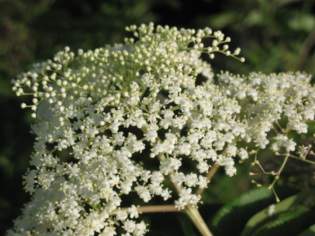Elderberry – Sambucus canadensis
Elderberries are a good addition to your home landscape and depending on your location, may be a good choice for an unusual edible fruit. Ripe fruit is used for jelly, wine, cordials, pies and even as an anti-viral medication1.
The hardiest plants are the North American varieties such as ‘Adams’, ‘York’, ‘Johns’, ‘Nova’, ‘Kent’ and ‘Scotia’, which are listed in publications as being suitable for growing in USDA hardiness zone 4. CREC had four demonstration plants of each of the first four cultivars in this list but none of them are fully hardy here.
At CREC, the elderberries grow quite well, easily reaching 60 to 85 inches in height in one season. They have disease-free foliage and beautiful umbels of white, sweetly-scented flowers. However, the stalk buds are not hardy above the snowline and the plants generally have to regrow each year. This fast renewal growth may be an advantage in some home landscaping situations.
In 2010, buds were able to survive two feet above the ground, where they had been buried in snow. As the first fruit was reaching maximum size, younger flowers were forming on the later growth. These flowers were removed to allow the plants to direct their energy toward ripening the oldest fruit. Despite these efforts and an early spring, the fruit was still not able to ripen.
On several occasions, visitors have told us about elderberry fruit that ripens in their North Dakota gardens. We have obtained several of these plants and we are looking to acquire some selections from Nebraska that are hardier than those available commercially.
In 2011, most of the original elderberry plants were removed to make way for these new elderberries.
- Zakay-Rones Z, Thom E, Wollan T and Wadstein J. Randomized study of the efficacy and safety of oral elderberry extract in the treatment of influenza A and B virus infections. JIMR. 2004. 32: 132-140


